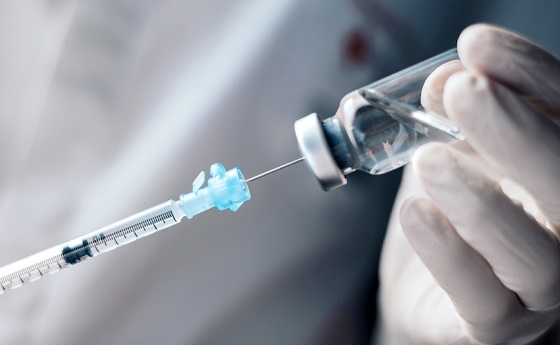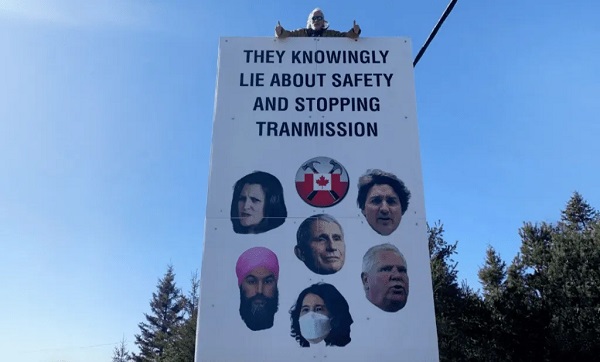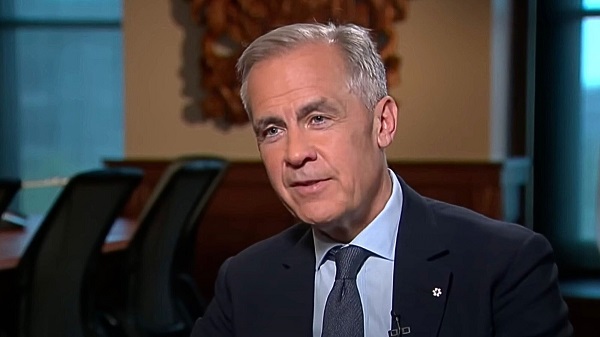Health
Prostate Cancer: Over-Testing and Over-Treatment

From the Brownstone Institute
By
The excessive medical response to the Covid pandemic made one thing abundantly clear: Medical consumers really ought to do their own research into the health issues that impact them. Furthermore, it is no longer enough simply to seek out a “second opinion” or even a “third opinion” from doctors. They may well all be misinformed or biased. Furthermore, this problem appears to predate the Covid phenomenon.
A striking example of that can be found in the recent history of prostate cancer testing and treatment, which, for personal reasons, has become a subject of interest to me. In many ways, it strongly resembles the Covid calamity, where misuse of the PCR test resulted in harming the supposedly Covid-infected with destructive treatments.
Two excellent books on the subject illuminate the issues involved in prostate cancer. One is Invasion of the Prostate Snatchers by Dr. Mark Scholz and Ralph Blum. Dr. Scholtz is executive director of the Prostate Cancer Research Institute in California. The other is The Great Prostate Hoax by Richard Ablin and Ronald Piana. Richard Ablin is a pathologist who invented the PSA test but has become a vociferous critic of its widespread use as a diagnostic tool for prostate cancer.
Mandatory yearly PSA testing at many institutions opened up a gold mine for urologists, who were able to perform lucrative biopsies and prostatectomies on patients who had PSA test numbers above a certain level. However, Ablin has insisted that “routine PSA screening does far more harm to men than good.” Moreover, he maintains that the medical people involved in prostate screening and treatment represent “a self-perpetuating industry that has maimed millions of American men.”
Even during approval hearings for the PSA test, the FDA was well aware of the problems and dangers. For one thing, the test has a 78% false positive rate. An elevated PSA level can be caused by various factors besides cancer, so it is not really a test for prostate cancer. Moreover, a PSA test score can spur frightened men into getting unnecessary biopsies and harmful surgical procedures.
One person who understood the potential dangers of the test well was the chairman of the FDA’s committee, Dr. Harold Markovitz, who decided whether to approve it. He declared, “I’m afraid of this test. If it is approved, it comes out with the imprimatur of the committee…as pointed out, you can’t wash your hands of guilt. . .all this does is threaten a whole lot of men with prostate biopsy…it’s dangerous.”
In the end, the committee did not give unqualified approval to the PSA test but only approved it “with conditions.” However, subsequently, the conditions were ignored.
Nevertheless, the PSA test became celebrated as the route to salvation from prostate cancer. The Postal Service even circulated a stamp promoting yearly PSA tests in 1999. Quite a few people became wealthy and well-known at the Hybritech company, thanks to the Tandem-R PSA test, their most lucrative product.
In those days, the corrupting influence of the pharmaceutical companies on the medical device and drug approval process was already apparent. In an editorial for the Journal of the American Medical Association (quoted in Albin and Piana’s book), Dr. Marcia Angell wrote, “The pharmaceutical industry has gained unprecedented control over the evaluation of its products…there’s mounting evidence that they skew the research they sponsor to make their drugs look better and safer.” She also authored the book The Truth About the Drug Companies: How They Deceive Us and What to Do About It.
A cancer diagnosis often causes great anxiety, but in actuality, prostate cancer develops very slowly compared to other cancers and does not often pose an imminent threat to life. A chart featured in Scholz and Blum’s book compares the average length of life of people whose cancer returns after surgery. In the case of colon cancer, they live on average two more years, but prostate cancer patients live another 18.5 years.
In the overwhelming majority of cases, prostate cancer patients do not die from it but rather from something else, whether they are treated for it or not. In a 2023 article about this issue titled “To Treat or Not to Treat,” the author reports the results of a 15-year study of prostate cancer patients in the New England Journal of Medicine. Only 3% of the men in the study died of prostate cancer, and getting radiation or surgery for it did not seem to offer much statistical benefit over “active surveillance.”
Dr. Scholz confirms this, writing that “studies indicate that these treatments [radiation and surgery] reduce mortality in men with Low and Intermediate-Risk disease by only 1% to 2% and by less than 10% in men with High-Risk disease.”
Nowadays prostate surgery is a dangerous treatment choice, but it is still widely recommended by doctors, especially in Japan. Sadly, it also seems to be unnecessary. One study cited in Ablin and Piana’s book concluded that “PSA mass screening resulted in a huge increase in the number of radical prostatectomies. There is little evidence for improved survival outcomes in the recent years…”
However, a number of urologists urge their patients not to wait to get prostate surgery, threatening them with imminent death if they do not. Ralph Blum, a prostate cancer patient, was told by one urologist, “Without surgery you’ll be dead in two years.” Many will recall that similar death threats were also a common feature of Covid mRNA-injection promotion.
Weighing against prostate surgery are various risks, including death and long-term impairment, since it is a very difficult procedure, even with newer robotic technology. According to Dr. Scholz, about 1 in 600 prostate surgeries result in the death of the patient. Much higher percentages suffer from incontinence (15% to 20%) and impotence after surgery. The psychological impact of these side effects is not a minor problem for many men.
In light of the significant risks and little proven benefit of treatment, Dr. Scholz censures “the urology world’s persistent overtreatment mindset.” Clearly, excessive PSA screening led to inflicting unnecessary suffering on many men. More recently, the Covid phenomenon has been an even more dramatic case of medical overkill.
Ablin and Piana’s book makes an observation that also sheds a harsh light on the Covid medical response: “Isn’t cutting edge innovation that brings new medical technology to the market a good thing for health-care consumers? The answer is yes, but only if new technologies entering the market have proven benefit over the ones they replace.”
That last point especially applies to Japan right now, where people are being urged to receive the next-generation mRNA innovation–the self-amplifying mRNA Covid vaccine. Thankfully, a number seem to be resisting this time.
Health
‘Transgender’ males have 51% higher death rate than general population: study

From LifeSiteNews
Research found that men who underwent a ‘gender transition’ using hormones have a 51% higher mortality rate than the general population and a ‘threefold’ greater risk of cardiovascular deaths.
A newly published study has found that males’ use of estrogen to present as “female” triples their risk of cardiovascular disease, while also heightening the risk of stroke, blood clots, depression, and cognitive impairment.
The journal Discover Mental Health on June 12 released a variety of findings regarding the negative impacts of estrogen use in males attempting to transition to “female.” One of the most significant was that current estrogen use “was associated with a threefold increased risk of death from cardiovascular events.”
In fact, a study of 966 “female transitioned” males were found to have a mortality rate 51 percent higher than that of the general population. Their main causes of death included cardiovascular disease (21 percent), cancer (32 percent), suicide (7.5 percent), and infection-related disease (five percent).
Estrogen use by males amplified other cardiovascular risks, especially with prolonged use. One meta-analysis found a 30 percent higher rate of stroke among gender-confused men who took estrogen compared with men who did not.
A review also found “strong evidence” that estrogen use by men increases their risk for vein blood clots “over fivefold.”
Estrogen use was also found to have a detrimental cognitive impact on men. For example, so-called “female transitioned” males were found to have lower scores than both their other male counterparts and women in “information-processing speed and episodic memory.”
In addition, elevated symptoms of depression were “associated with increased serum levels of estradiol” for men under the age of 60.
This recent study confirms 2023 study that found that all gender-confused individuals, whether men attempting to present themselves as women or women attempting to present themselves as men, were at significantly increased risk for a range of deadly cardiovascular conditions, including strokes, heart attacks, high blood pressure, and elevated cholesterol levels.
A 2019 study published by the National Institutes of Health (NIH) National Library of Medicine also found:
Cardiovascular disease (CVD) is the leading disease-specific cause of death for [so-called] transgender people undergoing [transgender procedures], with only suicide claiming more lives as the leader of all cause mortality.
However, for [gender-confused males], the risk of death from CVD is 3-fold higher than for all other groups.
Research reported by both the British Heart Association and the American Heart Association that same year arrived at similar findings:
“We already know sex hormones are important to cardiovascular health, and now we have people being exposed to high levels of sex hormones they normally would not have, which could be associated with cardiovascular benefit or risk,” said Dr. Christian Delles, a professor at the Institute of Cardiovascular and Medical Sciences at the University of Glasgow.
Brownstone Institute
FDA Exposed: Hundreds of Drugs Approved without Proof They Work

From the Brownstone Institute
By
The US Food and Drug Administration (FDA) has approved hundreds of drugs without proof that they work—and in some cases, despite evidence that they cause harm.
That’s the finding of a blistering two-year investigation by medical journalists Jeanne Lenzer and Shannon Brownlee, published by The Lever.
Reviewing more than 400 drug approvals between 2013 and 2022, the authors found the agency repeatedly ignored its own scientific standards.
One expert put it bluntly—the FDA’s threshold for evidence “can’t go any lower because it’s already in the dirt.”
A System Built on Weak Evidence
The findings were damning—73% of drugs approved by the FDA during the study period failed to meet all four basic criteria for demonstrating “substantial evidence” of effectiveness.
Those four criteria—presence of a control group, replication in two well-conducted trials, blinding of participants and investigators, and the use of clinical endpoints like symptom relief or extended survival—are supposed to be the bedrock of drug evaluation.
Yet only 28% of drugs met all four criteria—40 drugs met none.
These aren’t obscure technicalities—they are the most basic safeguards to protect patients from ineffective or dangerous treatments.
But under political and industry pressure, the FDA has increasingly abandoned them in favour of speed and so-called “regulatory flexibility.”
Since the early 1990s, the agency has relied heavily on expedited pathways that fast-track drugs to market.
In theory, this balances urgency with scientific rigour. In practice, it has flipped the process. Companies can now get drugs approved before proving that they work, with the promise of follow-up trials later.
But, as Lenzer and Brownlee revealed, “Nearly half of the required follow-up studies are never completed—and those that are often fail to show the drugs work, even while they remain on the market.”
“This represents a seismic shift in FDA regulation that has been quietly accomplished with virtually no awareness by doctors or the public,” they added.
More than half the approvals examined relied on preliminary data—not solid evidence that patients lived longer, felt better, or functioned more effectively.
And even when follow-up studies are conducted, many rely on the same flawed surrogate measures rather than hard clinical outcomes.
The result: a regulatory system where the FDA no longer acts as a gatekeeper—but as a passive observer.
Cancer Drugs: High Stakes, Low Standards
Nowhere is this failure more visible than in oncology.
Only 3 out of 123 cancer drugs approved between 2013 and 2022 met all four of the FDA’s basic scientific standards.
Most—81%—were approved based on surrogate endpoints like tumour shrinkage, without any evidence that they improved survival or quality of life.
Take Copiktra, for example—a drug approved in 2018 for blood cancers. The FDA gave it the green light based on improved “progression-free survival,” a measure of how long a tumour stays stable.
But a review of post-marketing data showed that patients taking Copiktra died 11 months earlier than those on a comparator drug.
It took six years after those studies showed the drug reduced patients’ survival for the FDA to warn the public that Copiktra should not be used as a first- or second-line treatment for certain types of leukaemia and lymphoma, citing “an increased risk of treatment-related mortality.”
Elmiron: Ineffective, Dangerous—And Still on the Market
Another striking case is Elmiron, approved in 1996 for interstitial cystitis—a painful bladder condition.
The FDA authorized it based on “close to zero data,” on the condition that the company conduct a follow-up study to determine whether it actually worked.
That study wasn’t completed for 18 years—and when it was, it showed Elmiron was no better than placebo.
In the meantime, hundreds of patients suffered vision loss or blindness. Others were hospitalized with colitis. Some died.
Yet Elmiron is still on the market today. Doctors continue to prescribe it.
“Hundreds of thousands of patients have been exposed to the drug, and the American Urological Association lists it as the only FDA-approved medication for interstitial cystitis,” Lenzer and Brownlee reported.
“Dangling Approvals” and Regulatory Paralysis
The FDA even has a term—”dangling approvals”—for drugs that remain on the market despite failed or missing follow-up trials.
One notorious case is Avastin, approved in 2008 for metastatic breast cancer.
It was fast-tracked, again, based on ‘progression-free survival.’ But after five clinical trials showed no improvement in overall survival—and raised serious safety concerns—the FDA moved to revoke its approval for metastatic breast cancer.
The backlash was intense.
Drug companies and patient advocacy groups launched a campaign to keep Avastin on the market. FDA staff received violent threats. Police were posted outside the agency’s building.
The fallout was so severe that for more than two decades afterwards, the FDA did not initiate another involuntary drug withdrawal in the face of industry opposition.
Billions Wasted, Thousands Harmed
Between 2018 and 2021, US taxpayers—through Medicare and Medicaid—paid $18 billion for drugs approved under the condition that follow-up studies would be conducted. Many never were.
The cost in lives is even higher.
A 2015 study found that 86% of cancer drugs approved between 2008 and 2012 based on surrogate outcomes showed no evidence that they helped patients live longer.
An estimated 128,000 Americans die each year from the effects of properly prescribed medications—excluding opioid overdoses. That’s more than all deaths from illegal drugs combined.
A 2024 analysis by Danish physician Peter Gøtzsche found that adverse effects from prescription medicines now rank among the top three causes of death globally.
Doctors Misled by the Drug Labels
Despite the scale of the problem, most patients—and most doctors—have no idea.
A 2016 survey published in JAMA asked practising physicians a simple question—what does FDA approval actually mean?
Only 6% got it right.
The rest assumed that it meant the drug had shown clear, clinically meaningful benefits—such as helping patients live longer or feel better—and that the data was statistically sound.
But the FDA requires none of that.
Drugs can be approved based on a single small study, a surrogate endpoint, or marginal statistical findings. Labels are often based on limited data, yet many doctors take them at face value.
Harvard researcher Aaron Kesselheim, who led the survey, said the results were “disappointing, but not entirely surprising,” noting that few doctors are taught about how the FDA’s regulatory process actually works.
Instead, physicians often rely on labels, marketing, or assumptions—believing that if the FDA has authorized a drug, it must be both safe and effective.
But as The Lever investigation shows, that is not a safe assumption.
And without that knowledge, even well-meaning physicians may prescribe drugs that do little good—and cause real harm.
Who Is the FDA Working for?
In interviews with more than 100 experts, patients, and former regulators, Lenzer and Brownlee found widespread concern that the FDA has lost its way.
Many pointed to the agency’s dependence on industry money. A BMJ investigation in 2022 found that user fees now fund two-thirds of the FDA’s drug review budget—raising serious questions about independence.

Yale physician and regulatory expert Reshma Ramachandran said the system is in urgent need of reform.
“We need an agency that’s independent from the industry it regulates and that uses high-quality science to assess the safety and efficacy of new drugs,” she told The Lever. “Without that, we might as well go back to the days of snake oil and patent medicines.”
For now, patients remain unwitting participants in a vast, unspoken experiment—taking drugs that may never have been properly tested, trusting a regulator that too often fails to protect them.
And as Lenzer and Brownlee conclude, that trust is increasingly misplaced.
- Investigative report by Jeanne Lenzer and Shannon Brownlee at The Lever [link]
- Searchable public drug approval database [link]
- See my talk: Failure of Drug Regulation: Declining standards and institutional corruption
Republished from the author’s Substack
-

 COVID-197 hours ago
COVID-197 hours agoOntario man launches new challenge against province’s latest attempt to ban free expression on roadside billboards
-

 Energy15 hours ago
Energy15 hours agoThis Canada Day, Celebrate Energy Renewal
-

 Business1 day ago
Business1 day agoWhile China Hacks Canada, B.C. Sends Them a Billion-Dollar Ship Building Contract
-

 Alberta1 day ago
Alberta1 day agoSo Alberta, what’s next?
-

 Alberta6 hours ago
Alberta6 hours agoAlberta Next Takes A Look At Alberta Provincial Police Force
-

 Bjorn Lomborg1 day ago
Bjorn Lomborg1 day agoThe Physics Behind The Spanish Blackout
-

 Alberta8 hours ago
Alberta8 hours agoCanadian Oil Sands Production Expected to Reach All-time Highs this Year Despite Lower Oil Prices
-

 Business10 hours ago
Business10 hours agoPotential For Abuse Embedded In Bill C-5






